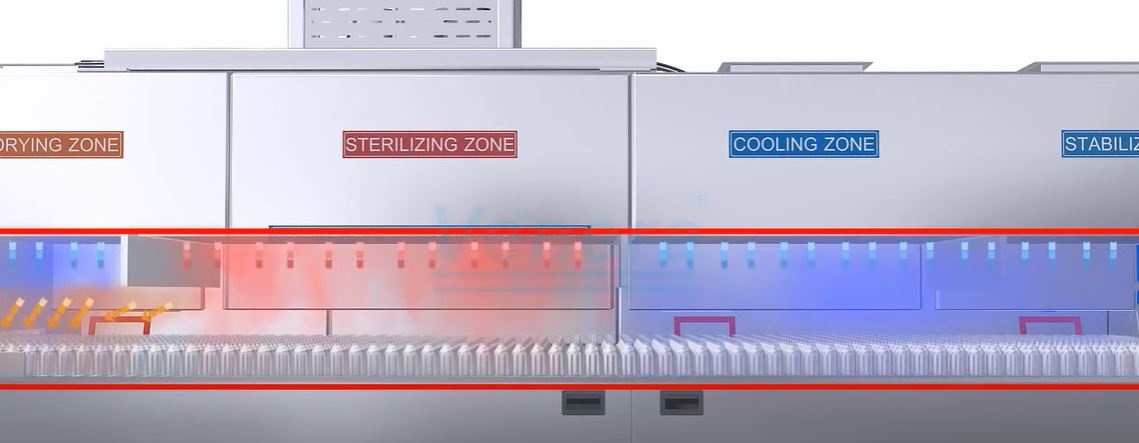Depyrogenation vs. sterilization these two terms may seem similar but, these are important processes/ methods used in industries such as pharmaceuticals and medical devices to ensure the safety and effectiveness of products. Let’s discuss one by one.
What is Depyrogenation?
The process of removal or inactivation of pyrogens from a product or surface is known as depyrogenation. Pyrogens are substances/agents that can alter body temperature, and they are often found in bacteria and endotoxins. In pharmaceutical manufacturing, pyrogens can be inter into products during production, packaging, or storage activity. if this happens they may enter the patient’s body, particularly in parenteral drug products (such as injections or IV drips), which are directly injected into the bloodstream.

Depyrogenation Methods:
The different methods used for depyrogenation as given below:
Dry Heat: Dry Heat Depyrogenation is the most common method. This method involves exposing the product or surface to high temperatures, typically between 250-350°C, for a specified period. Basically, in this method, The heat destroys the pyrogens and makes the surface or product pyrogen-free.
Steam: Steaming to the product involves exposing the product or surface to high-temperature steam, it is typically between 250-300°C, for a specified period making the pyrogen-free product.
Filtration: Filtration is the most reliable method that is more useful for heat-sensitive products. This method involves passing the product or solution through a membrane (made up of cellulose) filter with a pore size small enough to remove endotoxins and other pyrogenic substances.
What is Sterilization?
The process of eliminating or destroying all forms of microbial life, including bacteria, viruses, fungi, and spores, is known as sterilization. This process is critical for products that must be free of microorganisms that could harm patients or compromise the product’s effectiveness. Surgical instruments, implantable devices, and medical equipment are all examples of sterilization in the medical industry.
Sterilization Methods:
The different methods used for sterilization are discussed below:
Steam Sterilization: Steam Sterilization also refers to autoclaving, it involves exposing a specific product or surface to high-temperature steam (between 121-134°C) for a specific period range. The combination of high temperature and pressure of the steam effectively kills all microorganisms.
Dry Heat Sterilization: Dry Heat Sterilization is the most common universal method. it involves exposing a product or its surface to high temperatures (between 160-180°C) for a specified period to kill all microorganisms.
Ethylene Oxide Gas Sterilization: The gas Sterilization method involves exposing the product or its surface to a gas that is toxic to microorganisms. The gas penetrates the layer and kills all microorganisms.
Radiation Sterilization: This method is also very common and effective, commonly used for medical equipment and supplies. This method involves ionizing radiation (such as gamma rays) used to kill microorganisms.
Chemical Sterilants: In this method, chemical agents are used to kill microorganisms. Examples include hydrogen peroxide and glutaraldehyde.
Examples of Depyrogenation vs. Sterilization:
Depyrogenation, for example, is used in the manufacture of parenteral drugs such as injections or IV drips. To avoid adverse reactions in patients, these products must be free of pyrogens.
Sterilization for example, Stainless steel, and article item surgical items, must be sterile. If Talk about Medical device industries Implantable devices, such as pacemakers, must also be sterile To prevent infection and ensure proper device operation.
Conclusion
In the pharmaceutical and medical industries, depyrogenation and sterilization both methods are very effective in removing any harmful organisms. Depyrogenation is the process of removing or inactivating pyrogens, whereas sterilization is the process of eliminating all forms of microbial life. Understanding the differences between these processes is important for ensuring product safety, which may help to prevent the patients from Harmful Pathogens.

Naresh Bhakar is the Founder and Author at Pharmaguddu.com, bringing his extensive expertise in the field of pharmaceuticals to readers worldwide. He has experience in Pharma manufacturing and has worked with top Pharmaceuticals. He has rich knowledge and provides valuable insights and data through his articles and content on Pharmaguddu.com. For further inquiries or collaborations, please don’t hesitate to reach out via email at [email protected].
